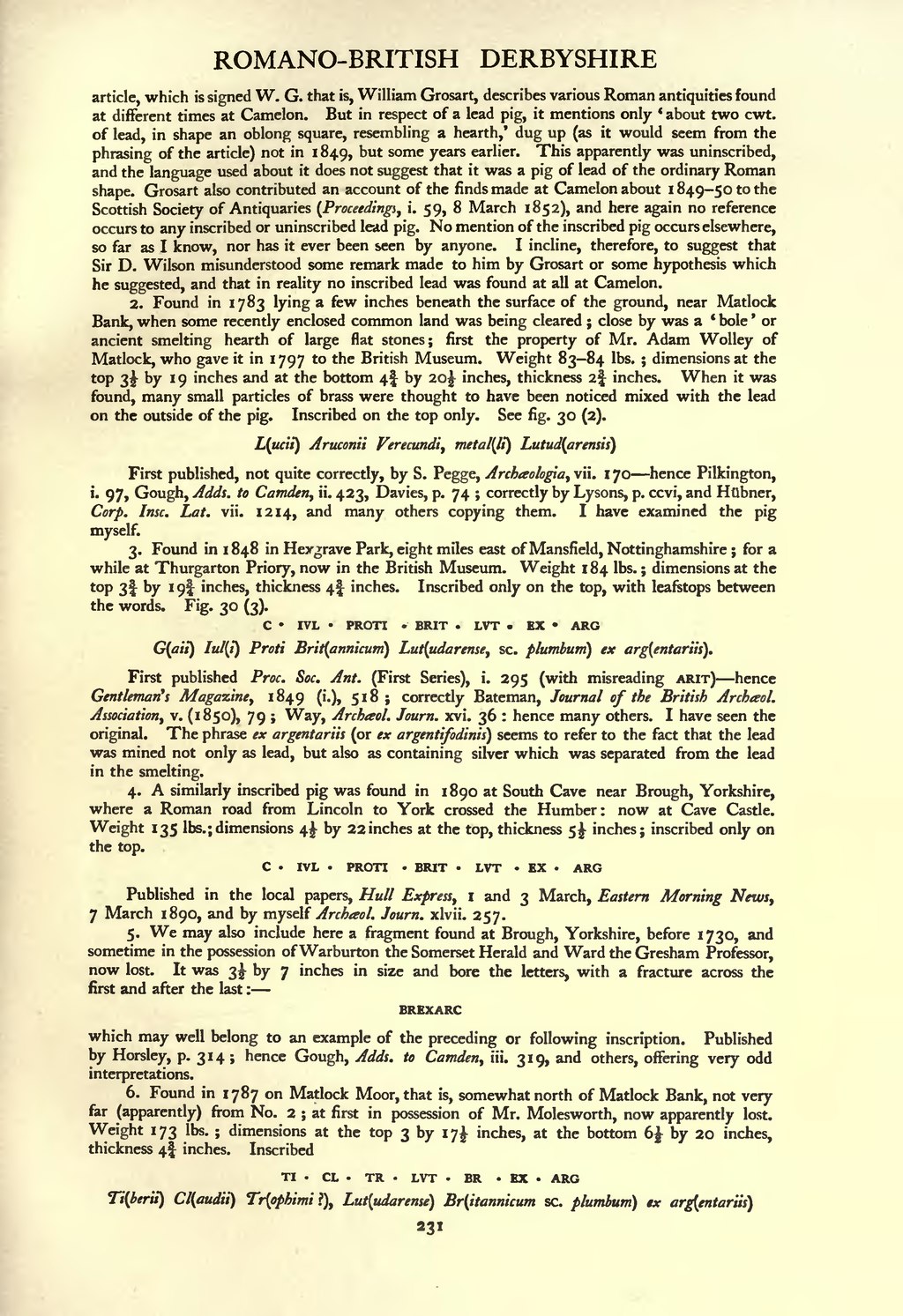ROMANO-BRITISH DERBYSHIRE article, which is signed W. G. that is, William Grosart, describes various Roman antiquities found at different times at Camelon. But in respect of a lead pig, it mentions only ' about two cwt. of lead, in shape an oblong square, resembling a hearth,' dug up (as it would seem from the phrasing of the article) not in 1849, but some years earlier. This apparently was uninscribed, and the language used about it does not suggest that it was a pig of lead of the ordinary Roman shape. Grosart also contributed an account of the finds made at Camelon about 1849-50 to the Scottish Society of Antiquaries (Proceedings, i. 59, 8 March 1852), and here again no reference occurs to any inscribed or uninscribed lead pig. No mention of the inscribed pig occurs elsewhere, so far as I know, nor has it ever been seen by anyone. I incline, therefore, to suggest that Sir D. Wilson misunderstood some remark made to him by Grosart or some hypothesis which he suggested, and that in reality no inscribed lead was found at all at Camelon. 2. Found in 1783 lying a few inches beneath the surface of the ground, near Matlock Bank, when some recently enclosed common land was being cleared ; close by was a ' bole ' or ancient smelting hearth of large flat stones ; first the property of Mr. Adam Wolley of Matlock, who gave it in 1797 to the British Museum. Weight 83-84 Ibs. ; dimensions at the top 3^ by 19 inches and at the bottom 4^ by 20^ inches, thickness 2 inches. When it was found, many small particles of brass were thought to have been noticed mixed with the lead on the outside of the pig. Inscribed on the top only. See fig. 30 (2). L(ucii) Aruconii Verecundi^ met a /(It) Lutud(arensis) First published, not quite correctly, by S. Pegge, Archteologia, vii. 1 70 hence Pilkington, i. 97, Gough, Adds, to Camden, ii. 423, Davies, p. 74 ; correctly by Lysons, p. ccvi, and Htlbner, Corp. Insc. Lot. vii. 1214, and many others copying them. I have examined the pig myself. 3. Found in 1848 in Hexgrave Park, eight miles east of Mansfield, Nottinghamshire ; for a while at Thurgarton Priory, now in the British Museum. Weight 1 84 Ibs. ; dimensions at the top 3f by 19$- inches, thickness 4f inches. Inscribed only on the top, with leafstops between the words. Fig. 30 (3). C IVL PROTI BRIT . LVT . EX ARG G(aif) Iul(t) Pratt Brit(annicum) Lut(udarense, sc. plumbum) ex arg(entariis). First published Proc. Sac. Ant. (First Series), i. 295 (with misreading ARIT) hence Gentleman's Magazine, 1849 (i.), 518; correctly Bateman, Journal of the British Archteol. Association, v. (1850), 79 ; Way, Archeeol. Journ. xvi. 36 : hence many others. I have seen the original. The phrase ex argentariis (or ex argentifodinis) seems to refer to the fact that the lead was mined not only as lead, but also as containing silver which was separated from the lead in the smelting. 4. A similarly inscribed pig was found in 1890 at South Cave near Brough, Yorkshire, where a Roman road from Lincoln to York crossed the Humber: now at Cave Castle. Weight 135 Ibs.; dimensions 4^ by 22 inches at the top, thickness 5^ inches; inscribed only on the top. C IVL PROTI BRIT LVT EX ARG Published in the local papers, Hull Express, i and 3 March, Eastern Morning News, 7 March 1890, and by myself Archteol. Journ. xlvii. 257. 5. We may also include here a fragment found at Brough, Yorkshire, before 1730, and sometime in the possession of Warburton the Somerset Herald and Ward the Gresham Professor, now lost. It was 3^ by 7 inches in size and bore the letters, with a fracture across the first and after the last : BREXARC which may well belong to an example of the preceding or following inscription. Published by Horsley, p. 314; hence Gough, Adds, to Camden, iii. 319, and others, offering very odd interpretations. 6. Found in 1787 on Matlock Moor, that is, somewhat north of Matlock Bank, not very far (apparently) from No. 2 ; at first in possession of Mr. Molesworth, now apparently lost. Weight 173 Ibs. ; dimensions at the top 3 by 17^ inches, at the bottom 6 by 20 inches, thickness 4! inches. Inscribed TI . CL TR LVT BR EX ARG Ti(berit) Cl(audii) Tr(ophimi ?), Lut(udarense) Br(itannicum sc. plumbum) ex arg(entariis) 231
